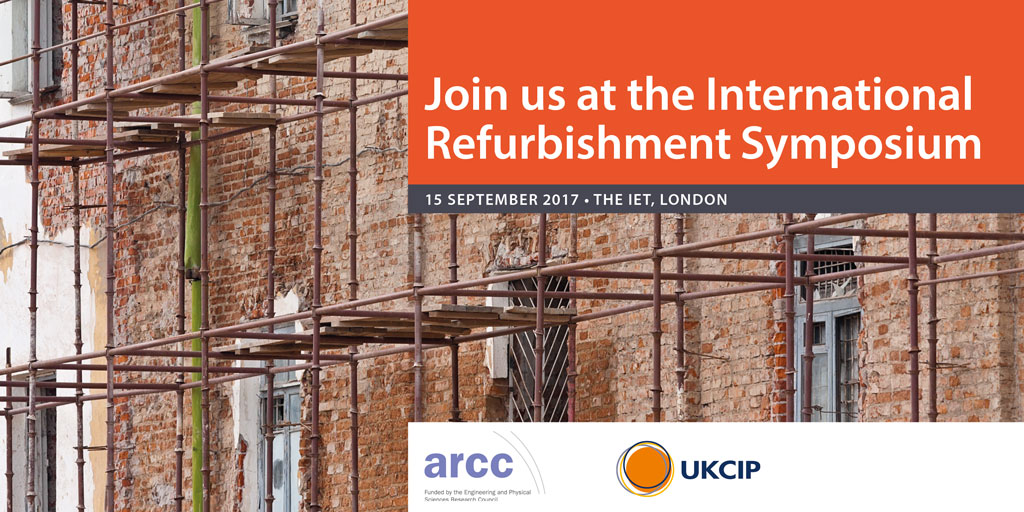Research Zone @ The International Refurbishment Symposium
15 September 2017, The IET, London
About the Research Zone
We’re pleased to showcase the latest research from EPSRC, supporting healthier homes as well as some of the future materials you may well see on the market in coming years.
You can speak directly to researchers about their work between 13:00–14:00. The Research Zone is open for the duration of the day so you can explore product displays, discover information sheets to take away, and link with social media activities across these leading research projects.
Join us on Twitter @ARCC_CN
Healthy Homes
UKCMB
Substantial building problems (including occupant health) are caused by excess or inadequate moisture in the form of ice, liquid or vapour. And yet we have very little research in the UK on moisture in buildings, and very little focus in standards, regulation, guidance or training on how to deal with moisture risks.
Government and industry is increasingly aware of these problems, with the consequence that the major standards for moisture in buildings (such as BS5250 and Part C) are currently being revised. In addition, a BSi White Paper which reframes moisture risk and process has been authored by Neil May CEO-UKCMB and Chris Sanders. Industry groups have commissioned reports on moisture risks in many areas. All of these, however, are being written in the face of huge uncertainty of methods, and lack of basic data and research.
The UK Centre for Moisture in Buildings which focuses on the causes, mechanisms and solutions to moisture problems is therefore necessary. It is long overdue, but is now an urgent requirement for this country, its building owners and occupiers, and the construction (and maintenance) industry.
- Neil May, University College London
MAGIC
The need to invest in healthy buildings is increasingly important- we continue to rely on traditional urban environmental control approaches that are energy-consuming and carbon/toxin producing heating, ventilation and cooling (HVAC) systems, but these produce an unsustainable cycle of increasing energy use and greenhouse gas emissions.
Can we develop a city with no air pollution and no heat-island effect by 2050?
If we are to succeed, we need to increase our understanding and knowledge of pollutant and air flow exchange within the built environment, understanding the impact of different building type, urban setting and building occupation. We also need to consider how to integrate alternative methods of climate change mitigation into our urban landscape, such as blue and green spaces for cooling and pollutant removal purposes.
- Elaine Paterson, Department of Applied Mathematics and Theoretical Physics, University of Cambridge
- MAGIC
ECO-SEE
Innovative eco-building materials inspired by nature that address poor air quality.
The ECO-SEE project developed new eco-materials and components for the purpose of creating both healthier and more energy efficient buildings. The consortium worked to create and symbiotically use natural eco-materials for healthier indoor environments through hygrothermal (heat and moisture) regulation and the removal of Volatile Organic Compounds through both chemical capture and photocatalysis.
- Dr Dan Maskell, Department of Architecture and Civil Engineering, University of Bath
- @BRECICM
Future materials
No Portland cement
A new brick-paving which contains no Portland cement yet retains material durability and other physical characteristics
This novel cement blend provides a lower production cost alternative to traditional Portland cement, enabling reduced carbon footprint of construction without adversely affecting material durability and other physical characteristics. It is a semi-dry cementitious material comprising of an alkali-activated binder for use in the production of paving blocks and roller-compacted concrete construction materials. The binder is made of three different non-hazardous mineral waste and by-product materials – granulated blast furnace slag, basic oxygen slag and an alkaline inorganic waste material, for example, by pass dust / cement kiln dust.
The cement blend is of the same consistency and properties as the conventional paving block mixtures and can be easily cast in a factory with the usual plant and machinery. Environmental benefits include the reuse of industrial / mineral waste materials and a lower water content requirement than conventional Portland cement.
It contains stainless steel wire fibre providing the following benefits:
- superior resistance to cracking in hardened state concrete
- maximum resistance to damage from heavy impact and dynamic loading.
- increased flexural toughness/residual strength
- improved post-crack performance
- increased impact and abrasion resistance
- Prof Eshmaiel Ganjian, School of Energy, Construction and Environment, Coventry University
- @covcampus
Old birds new tricks – rethinking waste feathers
At AEROPOWDER, the team are developing sustainable functional materials from feathers. As our society continues to grow, there is an increasing strain on the environment through the creation and disposal of products. In a similar manner, a growing global population also faces other pressures, namely the impacts of providing food to billions of individuals. 134 million birds are consumed every day across the world, and it is often forgotten that the feathers removed from chickens are a significant waste disposal issue.
By reusing feathers, not only can a waste resource be used intelligently but also allow for the creation of materials that will harness the natural properties of feathers to create environmentally friendly high performance materials. Feathers are inherently thermally insulating, so AEROPOWDER’s current focus is to develop insulation materials that can be used to insulate our buildings in a more sustainable manner. The team hope that one day soon their materials will be found all around the world, wherever waste feathers can be found.
- Ryan Robinson, AEROPOWDER (Co-Founder)
- AEROPOWDER


